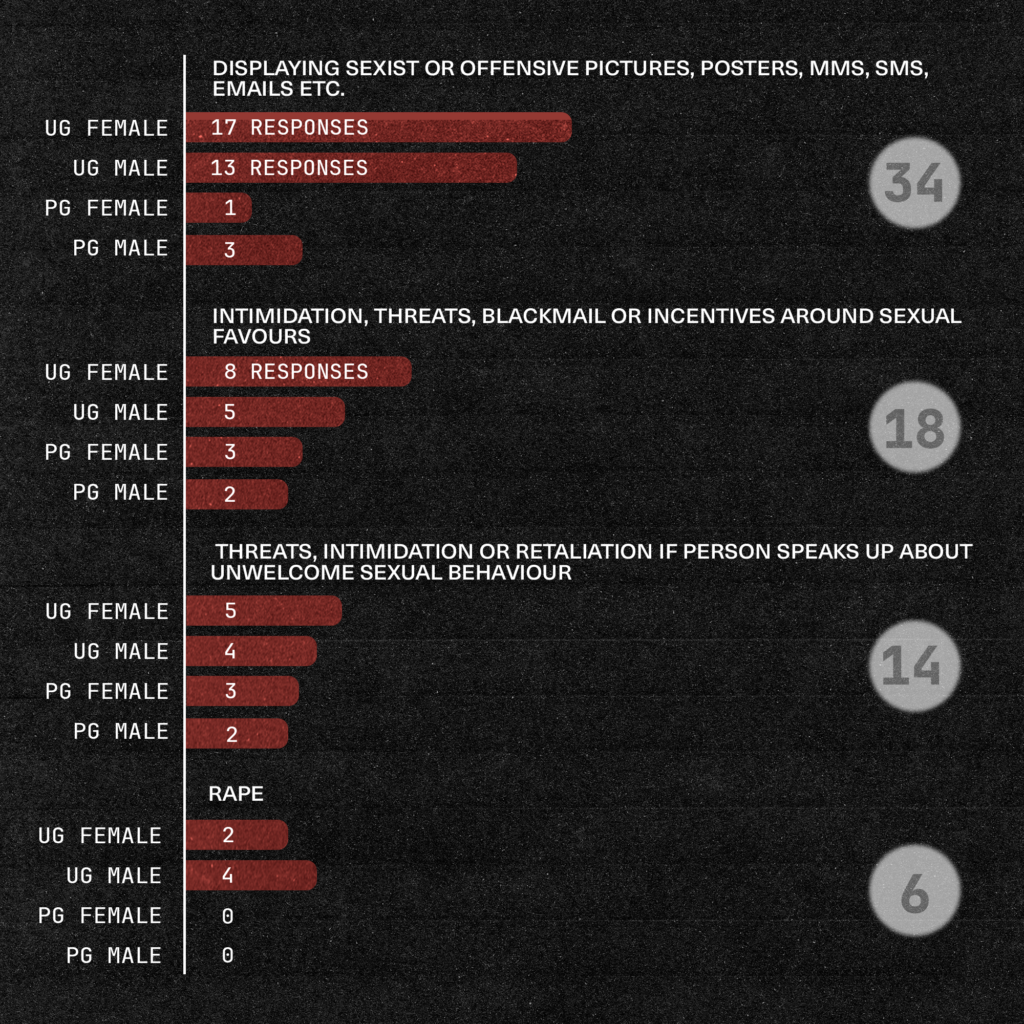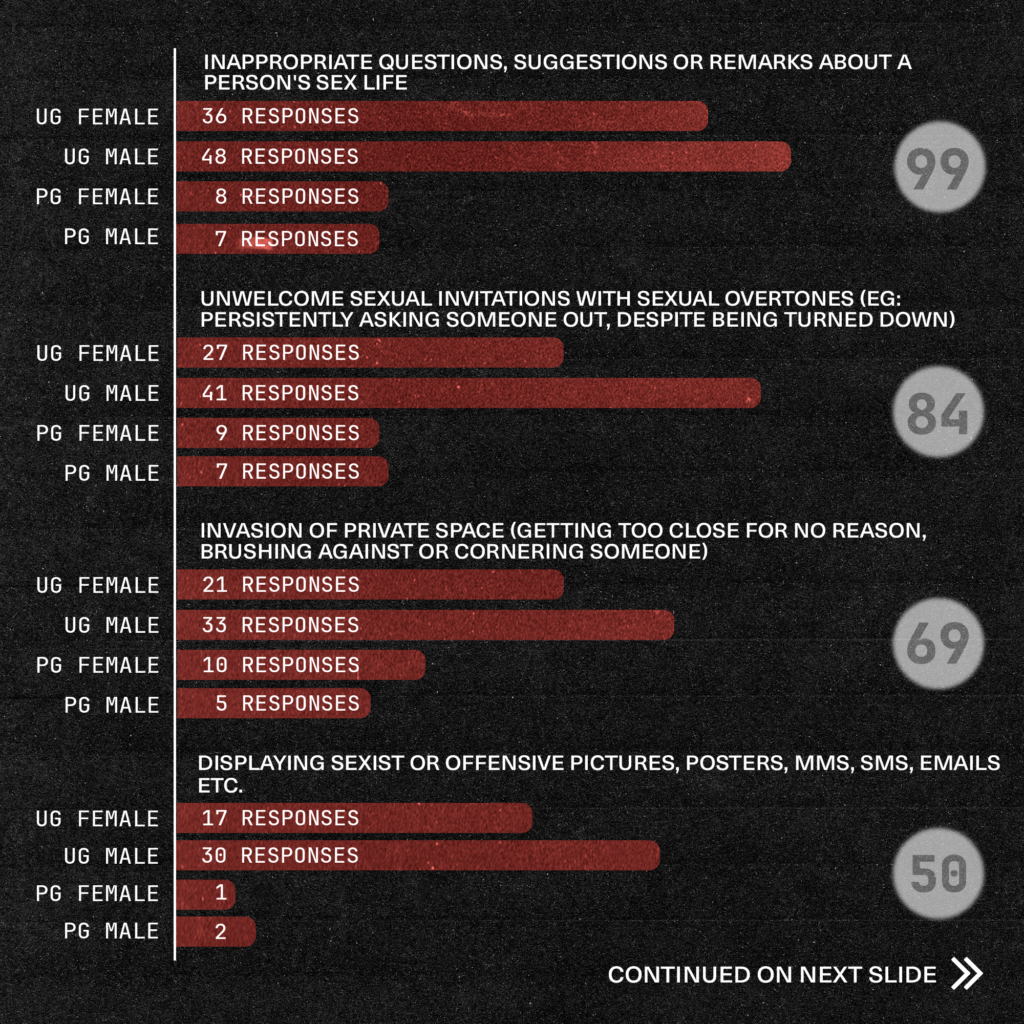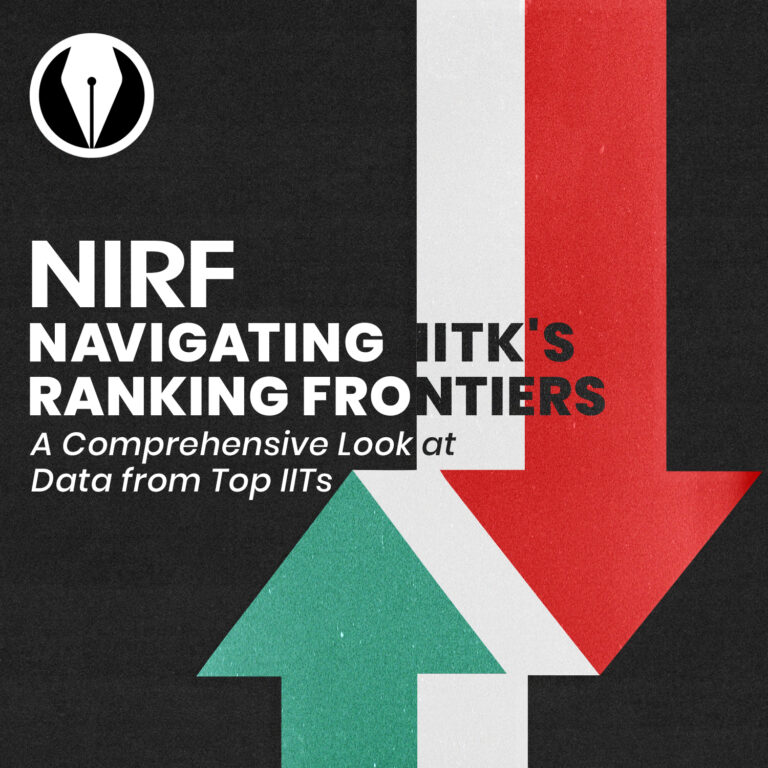**Disclaimer - These are results from an anonymous survey making the responses and their validity unverifiable. The responses may or may not reflect the actual scenario at IIT Kanpur. The purpose of the survey was to start a conversation around sexual harassment at iitk - but readers should keep in mind the limitations of an anonymous survey - while it allows people to share freely, the claims and their accuracy are not verified**
Amidst the beating hearts, smiling faces, and the chaos that was the Orientation’22, whispers about numerous cases of sexual harassment circled the campus. Incidents ranged from stalking to inappropriate touching, with reports not only from the latest batch but also from students in older batches. Later that year, girls were prohibited from entering hall-13 premises as a perceived measure of safety. This made us reflect critically on the nature, prevalence, and institutional response to such cases on campus. How do people understand sexual harassment? How prevalent is it? What becomes of such cases? These and many other such questions guided the following investigation.
Vox conducted a comprehensive survey on our campus. Our intent is to raise pertinent questions based on the data, initiating conversation on the broader implications.
Brief on the survey
The survey, done through an anonymous Google form, had three main parts. First, it asked about the respondent’s experiences of sexual harassment on campus, including some questions with multiple correct answers. Second, it looked at institutional bodies and experiences/perceptions surrounding them wanting to understand the role of institutional bodies in these situations. The third part focused on people’s ideas about and around sexual harassment. It ended by asking respondents about their awareness of the issue.
705 individuals contributed to this dataset. Among this group, 414 respondents (comprising 58.7% of the total) identified as male, while 281 individuals (constituting 39.8% of the respondents) identified as female, with one respondents identifying as non-binary. Additionally, the respondents included 565 undergraduate students and 130 postgraduate students (rest did not respond to the question).
In this article, we present the findings of this survey, aiming for an objective portrayal of data. It sheds light on the prevalence, extent, and nature of such incidents, exploring different aspects without immediately going to definitive answers. In subsequent editions, we will try to explore (via investigation) potential answers to these questions for a more comprehensive understanding of the landscape surrounding sexual harassment.
Current situation on campus
In response to the initial question that asked if the respondent had ever experienced sexual harassment on campus- the survey revealed that almost 25% of those surveyed have encountered some type of sexual harassment (as per this definition).

This means – nearly every 1 in 4 people who participated in the survey have experienced harassment in various forms. To gauge the situation better, we also inquired whether the respondents were aware of anyone who had faced sexual harassment.

The results reveal that close to 35% of participants know someone who has had similar experiences.
Notably, a significant portion of individuals, even if they personally haven’t experienced harassment, are aware of someone within their circles who has. This, to an extent, indicates that the issue of sexual harassment is not hidden; it exists within people’s awareness and is not invisibilised as much as we would like to believe – both through first-hand experiences or through accounts of similar experiences around them. This suggests a visibility greater than might initially appear.
Kind of harassment
Next, we attempt to understand in what form sexual harassment is prevalent on campus (the respondent could choose multiple options). We note that almost all forms of sexual harassment are present on campus, ranging from sexually suggestive remarks and sexist jokes to more serious cases of sexual assault.
The following graph is the same statistic with percentages sorted by male and female, UG and PG, combined to give a complete picture.
Relation with the perpetrator
Having found out that cases of harassment seem numerically significant – we enquire about the identity of the perpetrator. 119 of the 147 (81%) responses mentioned someone known to be the perpetrator. From the responses, the known person could further be divided on the basis of the power dynamics. 73% included romantic partners, friends, wingies or batchmates while 8% mentioned faculty or senior students as the perpetrator. The remaining 28 of the 147 (19%) comprised of the unknown people ranging from office clerk and mess worker to HC staff.

The data suggests then that harassment knows no boundaries and infiltrates all corners of campus life. From friends to faculty, mess workers to office clerks, it seems no nook is untouched by these incidents. Another obvious inference is that the perpetrator in more than half the cases is a friend/intimate partner and in a significant number of cases is at-least an acquaintance, i.e. someone you are familiar with.
Reportage
We have grown up hearing that reportage of harassment is an acute problem, especially in India where a lot of stigma is attached to such experiences. Does this dynamic reproduce itself within campus? We look at a few statistics around rates of reportage by respondents who faced harassment in some form or the other. Reporting here includes complaints made to either Women cell and ICC on campus or filing an FIR. This data is particularly important – it may help us gauge the barriers to reportage which are both internal (internalised notions about the consequences of reporting) and institutional (confidence in institute bodies).

It turns out that nearly 92% of our respondents who faced sexual harassment did not report the incident further. We specifically follow up this question by asking respondents why they did not report the incident. Out of 162 responses, ~44% felt that the incident was “too trivial to be reported”, 43% did not want to get involved in the resulting “drama”, 30% felt that “the situation would improve if I just ignored it”. The question was a checkbox type where more than one option could be marked.

A related question in the survey asked the respondents “When is the right time to report a case of sexual harassment?”. More than half the respondents thought that an incident should be reported “As soon as one feels uncomfortable”. The next two most popular responses were “If it keeps happening repeatedly” and “Only when it becomes extreme”. This may indicate that people have very varied beliefs on what constitutes harassment, insofar as the episode demands to be reported. We explore this heterogeneity later in the text.

In the next section we look at possible reasons behind the low rates of reportage. We have clubbed similar subjective responses into categories to isolate the problems. We try to raise some relevant questions –
1. Faith in Institutional Bodies (Women’s Cell, Counselling Service(CS), Institute Complaints Cell(ICC))
There were a set of responses that asserted their distrust in the bodies on campus.
“I don’t have any trust in WC or ICC.”
One response said “He was faculty, I thought that would become worse for me”.
Other similar responses included
“Got review from my seniors that Women’s cell will not help you much”,
“I don’t have faith in the institutional mechanism to address this. It will be emotionally taxing for me, because the process itself is difficult and I was also concerned about peers judging me for what happened.”
“I have handled such people in past institutes and complaining hasn’t led to any conclusive results. In my experience, perpetrators don’t usually get penalised harshly when there is a reputed autonomous institute at play”
“I do not consider the authorities or CS apt enough to understand and handle the case respectfully”
“Didn’t think it would be taken seriously going by previous records”
The responses reflect a sentiment of perceived mistrust and incompetence within the institutional bodies. These notions are likely rooted in either the first-hand experiences of the respondents or the collective experiences shared within their social circles within (or outside) the campus. In both scenarios, the question arises: what factors have led individuals to have such reservations concerning the institute bodies? An issue that is anyway extremely taboo-ised in the status-quo, needs the redressal bodies to establish a level of trust. Assuming that the responses to our survey are indicative of the larger population’s sentiments, some questions that arise are – Are the institute bodies aware of their perception within the campus community? If yes, have they taken steps to proactively address these concerns? Have they been responsive to the sentiments held by individuals? Have steps been taken to bridge the gap in trust and competence? – These are some questions we wish to delve into in later pieces.
2. Scared of People knowing, Victim Blaming
Many respondents expressed that they chose not to report the incident out of fear that it might become public knowledge and negatively impact their image. Some were concerned about being victim-blamed and having their character questioned. Additionally, they were weary about the potential ‘drama’ that might ensue as a result of reporting.
Some such responses read –
“I did not want to get involved in any type of ‘drama’”
“Afraid of what society will think about me”
“Scared of victim blaming and shaming”
“I was just too scared”
3. Relationship with the perpetrator
Earlier, we presented the respondent’s answer to “Who was the perpetrator?” and saw that while in most cases, the perpetrator is somebody you know well (friend, acquaintance), it may be anyone from a doctor at the Heath Center to a Faculty member.
The implications of this statistic raises some questions – Does the relationship between the victim and the perpetrator influence the victim’s response to the transgression? Does the close connection deter reporting, as victims may be reluctant to subject their friends to consequences? Some responses to “Why did you not report the incident?” read-
“He is my friend”
“The perpetrator in my case were my close friends – so I was also empathetic towards it”
In cases where the perpetrator is somebody in a position of authority ( such as faculty, PhD mentor etc) how does the victim address the issue despite the power dynamic? Some responses said –
“He was faculty, I thought that will become worse for me”
“I was in doubt whether the touch was intentional considering the old age of my supervisor”
These questions open a window into the complex interplay between personal relationships and the reporting of harassment incidents. Do redressal bodies on campus recognize the implications of these dynamics? Some responses said –
“No instant action taken by either Women Cell or ICC neither by my supervisor to make me feel safe in the lab. When I reported the incident to my supervisor, his behaviour was very insensitive…. I met Women Cell *redacted* her gesture of talking was also not very appropriate. Her questions and some comments were offending to me.”
4. Harassment is normalised
Following this, we received feedback mentioning the normalisation of particular types of sexual harassment. Normalisation here means that harassment is such a frequent phenomenon, that people tend to accept it as part of daily life- and hence have rationale to not do anything about it proactively.
“I felt it was too trivial to be reported” was the highest response
Multiple replies mentioned “Things like this happen all the time” as the reason for not reporting the case.
“The usage of sexually suggestive cuss words, and invasion of one’s privacy, seems rampant in IIT Kanpur. I did not want to be the odd one out – for one person alone cannot change the society. I can work on myself, and that’s all I can do. Perhaps IITK would be a better place if the students were more educated about socially appropriate speech and expression.”
This raises an essential question for consideration – What process leads to the normalisation of certain acts? How can we address things that are seen as normal for most, even if it causes discomfort to someone? Furthermore, it prompts an inquiry into the effectiveness of the sensitisation organised by the responsible campus authorities.
5. Wo(Men) Cell
Another set of responses come from (presumably) men who did not go ahead with reporting the incident because –
“I think no one will listen to men”
“I thought there is no cell for men that’s why”
“Ladkon ki sunta kon hai”
Awareness
Another statistic that adds some context to the one above is what people do and do not consider sexual harassment.
Students come from diverse backgrounds – from different cultures and different places. This means that for each one, internalised notions about gender, violence and (specifically) harassment differ considerably. This is exactly what the responses seem to show. We can conclude from the above data, at least, that the question of what constitutes sexual harassment has different answers for different people. What may be considered harassment to one person might be shrugged off as insignificant by another.
For instance, on the one hand, 63 respondents claim to be victims of invasion of private space (getting too close for no reason, brushing against or cornering someone) while at the same time 69 respondents do not consider invasion of private space (getting too close for no reason, brushing against or cornering someone) as a form of harassment. We see this trend across the different types of sexual harassment – where many people claim to have been victims of a particular kind of harassment, many others do not recognize that category as harassment at all.
**However, this way of interpreting is still speculation. There may be other ways of interpreting this occurrence. For example, one may explain the fact that not a lot of people consider sexually suggestive remarks as a form of sexual harassment because they feel it is a weaker form of harassment and not extreme enough to be classified as sexual harassment. Similarly, 33 people may not classify rape as a form of sexual harassment because they feel that rape may be too extreme to be classified as harassment and should not be clubbed into the same category.
In any case, this discrepancy in understanding may have strong implications. When individuals observe their peers failing to acknowledge certain experiences as instances of sexual harassment, it may contribute to a heightened sense of alienation and trauma for victims. Such circumstances could then diminish the likelihood of victims reporting the incidents further. This statistic underscores the importance of a collective understanding and awareness surrounding the nuances of sexual harassment and how it is experienced.
Sessions by the Women’s cell conducted during the orientation week in part aim to bridge this discrepancy in awareness. Having said that – do we need more elaborate ways of addressing the awareness problem – ways that involve deeper and continuous (longer) engagement with the topic? What might these ways look like?
Scope to think
Higher education in India has gone through what has been called a quiet revolution. Within Higher education institutions (HEIs), gender parity has almost become a reality with women constituting 42% of the student body (at the time of this survey) from 10% at independence. However, this surge means individuals coming from diverse socio-economic backgrounds converge in institutions like ours, each having their own internalised ideas about and around gender. Each of us brings our own set of beliefs and stereotypes, shaping our definitions of what’s appropriate. As families invest in the education of their daughters and sons, fostering aspirations for change, the need for ensuring gender safety becomes that much more important.
Our institute is a mosaic of culture, ideas and beliefs. Inside these walls is a microcosm of the broader society outside, and as such, it is essential that we address certain issues to shape a better society for tomorrow. In this series of articles, we will attempt to bring to attention aspects that deserve discussion. In this pursuit, we invite the readers to reach out to us with their experiences, analysis and interpretations of the data for the further parts of the series.
Design – Sanyam Shivhare, Shivam Rathore
Assistant Editors – Aujasvit Datta, Manasvi Nidugala, Mansi Patel, Vaneesha Kumar
Editor – Gauravi Chandak, Mutasim Khan
















